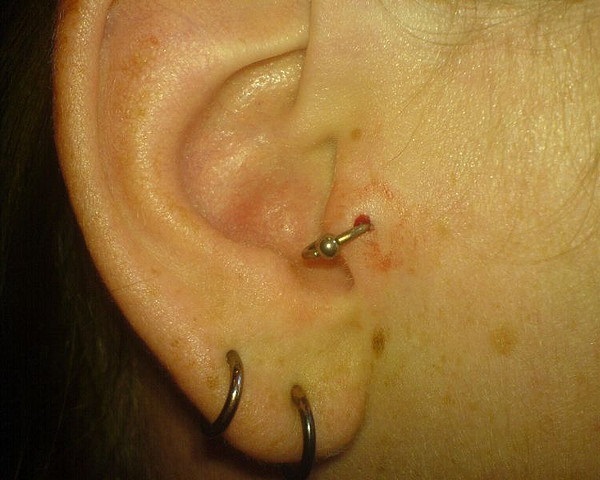Do you fear that the ear piercing you got done with so much excitement has infected your ear? Here are some tips to treat pierced ear infection.
Pierced Ear Infection
After a recent ear piercing, do you notice a slight swelling in the region around the piercing? Has the region reddened and does it itch slightly? Does the piercing also leak a dark green/ yellow fluid, which has a foul smell? If you are experiencing any of these symptoms then your piercing is infected. There will also exist a certain amount of normal soreness and redness because piercing is a painful procedure. Do not panic fearing it to be infection. In case of an infection, the area of the tissue affected is larger and it is definitely more painful. Pierced ears are very prone to infection, and it is essential that the first few days after the piercing you look after it with the utmost care. Even while getting the piercing done, make sure that the piercer is credible, and uses clean, sterile equipment. Picking the right jewelry also becomes very important; do not pick substances you are allergic to. Even after all the necessary precaution in case of an infection, consult the piercer or a physician immediately. Here are some tips on how to treat a pierced ear infection.

-
The first step is to remove the earrings from the ear at the first sign of infection.
-
Clean the earlobes and the earrings with sterile gauze; you could also apply a small amount of rubbing alcohol. However, do not use rubbing alcohol if your ear is newly pierced. Clean the earlobes at least three times in a day.
-
Draining the piercing wound and applying saline solution is also another way of treating the infection. Saline solution kills the bacteria and helps in the healing process.
-
Dissolve 1/8 tsp. of non-iodized salt in a cup of warm water. Dip a sterile cotton ball into the water, and then hold it gently against the infected pierced ear hole for several minutes. Do this at least 2 times in a day. Applying moist heat aids in the healing process.
-
Never use this treatment more than recommended, or use more salt than specified. Performing this treatment more than recommended can actually lead to a worse infection. Infections have a tendency to grow in wet areas; therefore keeping the region wet for too long can lead to worsening of the infection.
-
Make sure that after the treatment, you put the earrings back on, if you do not wear them for too long, the ear hole might close down resulting in you undergoing the painful procedure all over again.
-
If there is no improvement in the infection even after three to four days, you might have to consult a physician and use an antibiotic cream. Improvement in the infection implies that either the redness should reduce or the pus drainage should reduce, if either of the above doesn’t happen consult the physician again.
-
Do not keep touching the infected ear; many people have the tendency of constantly fiddling with the infected ear. Your hands need to be very clean while you touch the infected ear and you should wash them with antibacterial soap after touching them. This will prevent more germs from getting into the area and aggravating it.
-
Wear earrings made of pure metals such as silver or 24-karat gold or diamonds. Many people are sensitive to nickel, a metal commonly found in inexpensive earrings. Unfortunately, the allergic reaction can lead to an infection.
-
In case of a re-piercing due to excessive infection, wait for the ear to completely heal. Make sure that the piercing is not done in the same place again, i.e. chose a different location on the ear, as the chances of that region being again susceptible to infection is pretty high.
-
Even after the infection is completely healed it is essential that ear be kept clean. Continuous cleaning for up to six weeks after the piercing ensures an infection free piercing.
See also
More from iloveindia.com
- Home Remedies | Ayurveda | Vastu | Yoga | Feng Shui | Tattoos | Fitness | Garden | Nutrition | Parenting | Bikes | Cars | Baby Care | Indian Weddings | Festivals | Party ideas | Horoscope 2015 | Pets | Finance | Figures of Speech | Hotels in India : Delhi | Hyderabad | Chennai | Mumbai | Kolkata | Bangalore | Ahmedabad | Jaipur
- Contact Us Careers Disclaimer Privacy Policy Advertise With Us Lifestyle Sitemap Copyright iloveindia.com. All Rights Reserved.







